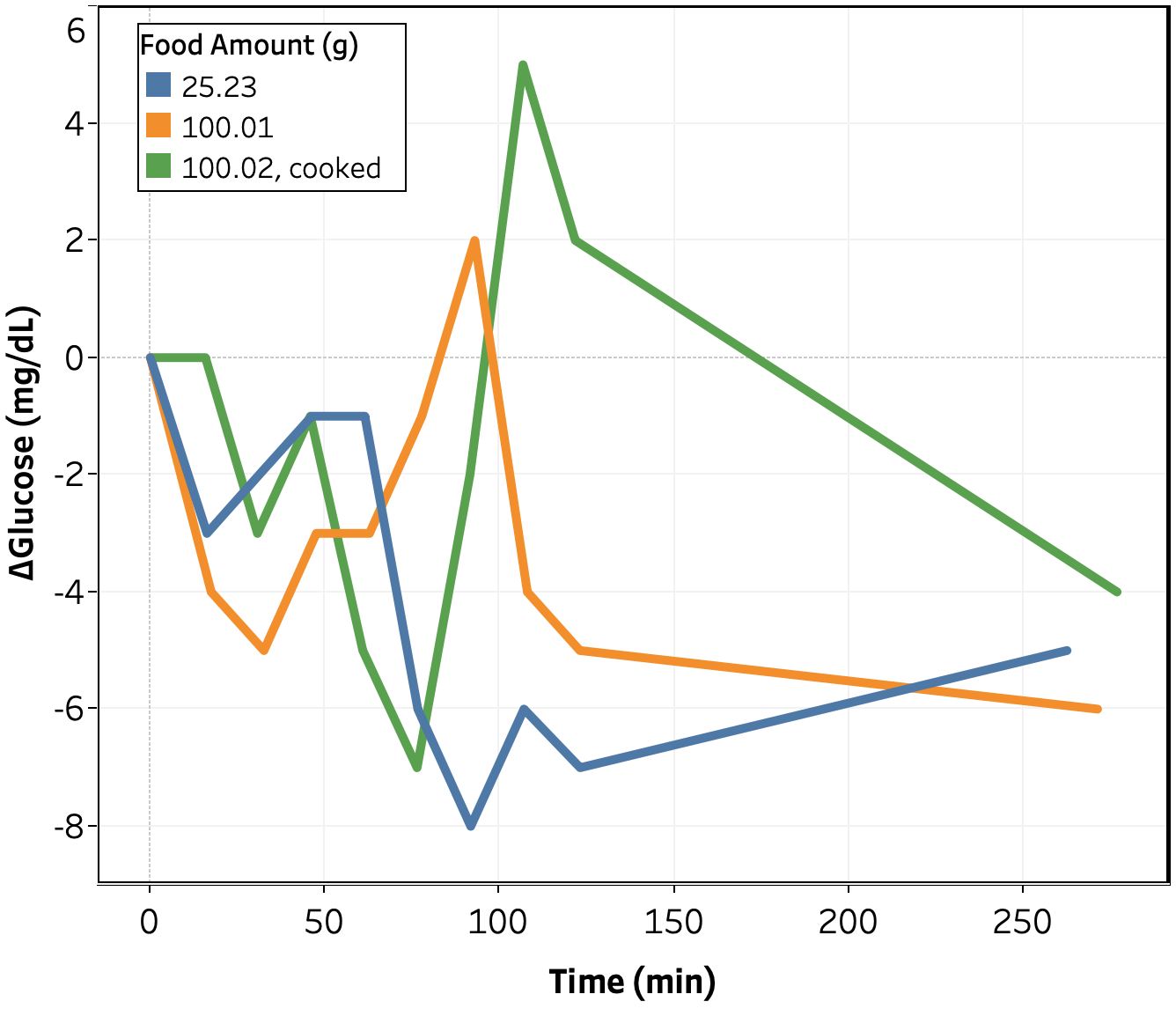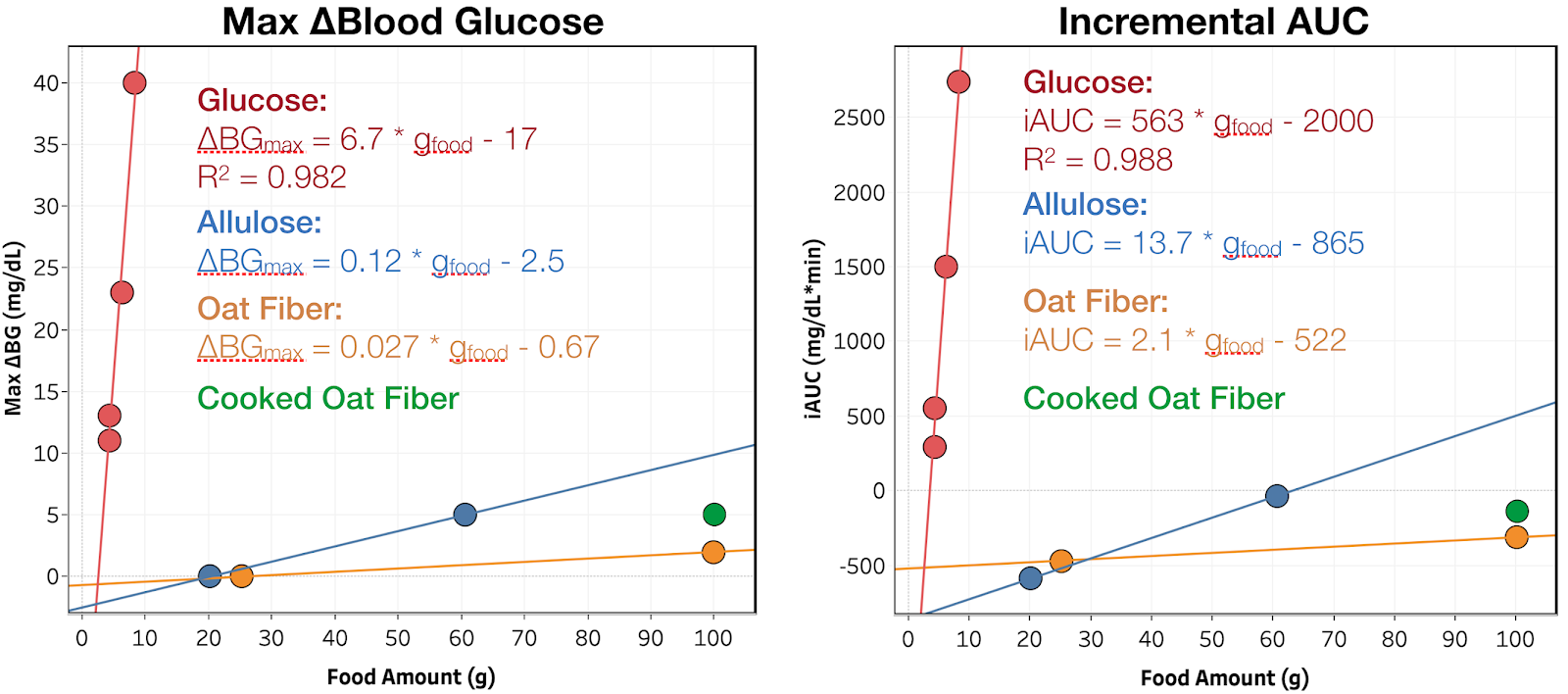Get new posts by email or rss feed
This self-experiment is being done as part of the Keating Memorial Self-Research Project. A couple of other people from the Open Humans community are also running the same experiments. If you’re interested in joining in, let me know in the comments or send me a PM.
This post is an update on my experiments measuring the effect of food ingredients on blood sugar.
Plan:
- Design experiments and solicit feedback: blog, Reddit, OpenHumans
- Calibrate continuous blood glucose meter: started 2/18, report tbd.
- Establish fasting baseline & determine time of day for experiments: Complete
- Food effect measurements
This week, I have the results from oat fiber and got started on whey protein.
Summary
Oat fiber has a negligible effect on my blood sugar, <0.05 mg/dL/g(oat fiber), or <0.5% that of glucose. Cooking the oat fiber had no significant effect. So, I’m safe to keep baking with it ☺.

Details
Purpose
To quantify the effect of ingestion of food ingredients and ingredient combinations on my blood sugar.
Ingredient Background
Oat fiber is an insoluble fiber made from grinding the shells of oat kernels. It’s purported to be completely indigestible, making it a great partial replacement for flour in low-carb baking when you don’t want the increased calories of almond or coconut flour. I personally have found it to be useful for making protein muffins and chocolate chip & coconut cookies.
Design/Methods
Procedure. From 7 pm the day before through 4:30p the day of experiment, no food or calorie-containing drinks were consumed and no exercise was performed. Non-calorie-containing drinks were consumed as desired (water, caffeine-free tea, and decaffeinated coffee). At ~12 pm, the substance to be tested was dissolved or suspended in 475 mL of water and ingested as rapidly as comfortable. For the cooked oat fiber, 100 g oat fiber was mixed with 200 g water and allowed to hydrate for 30 min. The mixture was then baked in a parchment lined muffin tin for 18 min. at 350 °F. The oat fiber was then suspended as described above. BGM measurements were then taken approximately every 15 min. for 2 h or until blood glucose had returned to baseline, whichever was longer. A final BGM measurement was taken 4.5 h after ingestion.
Measurements. Blood glucose was measured using a FreeStyle Libre flash glucose monitor and a FreeStyle Freedom Lite glucose meter with FreeStyle lancets & test strips. No special precautions were taken to clean the lancing site before measurement. To take a sample, the lancing devices was used to pierce the skin at an ~45 deg. angle from the finger. Blood was then squeezed out by running the thumb and pointer finger of the opposite hand from the first knuckle to the lancing site of the finger. Blood was then wicked into a test strip that had been inserted into the meter and the glucose reading was recorded.
Data Processing & Visualization. iAUC was calculated using the trapezoid method (see data spreadsheet for details). Data was visualized using Tableau.
Medication. I took my normal morning and evening medication, but did not dose for the experimental food ingested.
Data
Results & Discussion

Change in blood glucose as a function of time for the oat fiber tests is shown in Figure 1. Qualitatively, there appears to be no impact of oat fiber up to 100 g consumed. It was extremely uncomfortable to drink that much oat fiber in one sitting, so it’s unlikely I will ever eat more than that.

To better quantify the impact of glucose on my blood glucose, I plotted the maximum increase in blood glucose and the iAUC of blood glucose (incremental area under the curve) vs. amount consumed for all ingredients tested so far (see Figure 2). While the oat fiber data shows an increase in both blood glucose and iAUC as a function of amount consumed, there’s only two data points and the magnitude is extremely small and could easily be due to experimental error. Confirming this effect would require running more measurements. I may go back and do this later, but for the moment, I would prefer to focus my time on ingredients with unknown or more substantial effects.
Since oat fiber is used in baking, I also wanted to check if heating it would break down the fibers and increase digestibility. Towards that end, I mixed 100 g of oat fiber with 200 g of water and baked at 350 °F for 18 min. (time & temperature for my muffin recipe and longer than my cookie recipe), then suspended it in water using the same procedure as with the uncooked fiber. There was no observable change in appearance, taste, or texture from the cooking process. There was a very minor increase in blood glucose response, but well within the measurement error of the meter.
Conclusion & Next Experiments
Oat fiber has a negligible effect on my blood sugar, <0.05 mg/dL/g(oat fiber), or <0.5% that of glucose. Cooking the oat fiber had no significant effect. This week, I will measure the effect of whey protein, a common protein supplement.
– QD
Thank you so much for this information I’ve had lots of trouble with coconut flour and almond flour And I was wanting to give this a try I am a brittle type one diabetic With severe Insulin Resistance. This Will be a very good alternative To the other flours I have used.